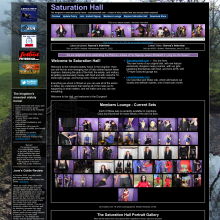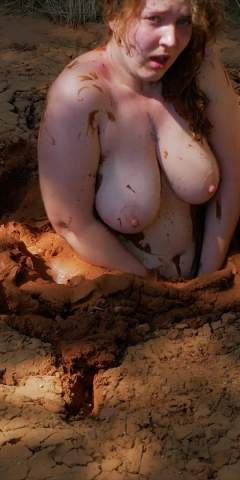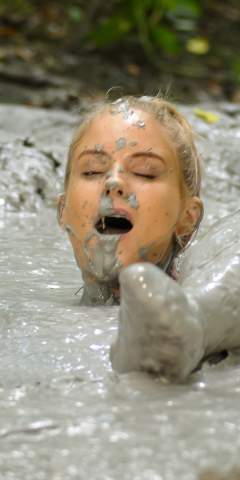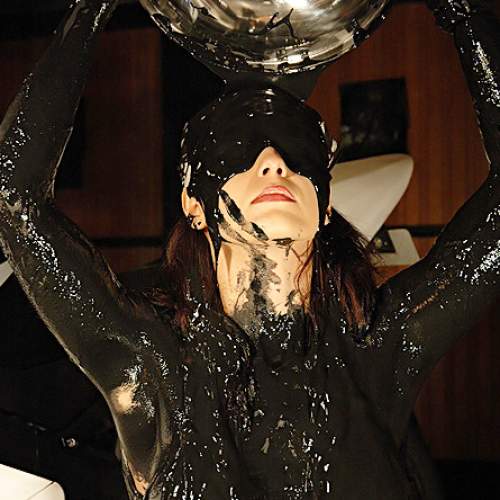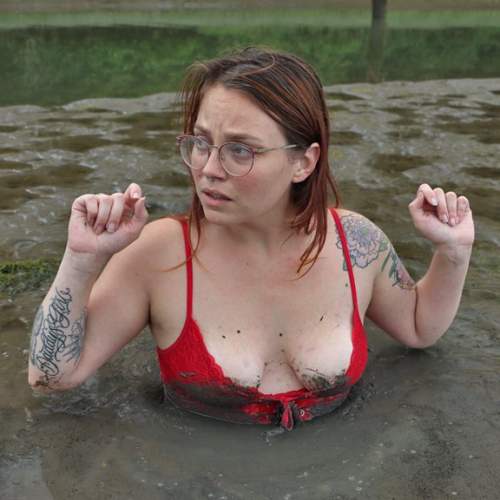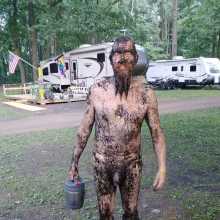|
|
|||
| forums: groups: | |||
|
"Honeysuckle gets a very proper and pious soaking!"
Saturation Hall, Langstonedale
Lord of the Pies
The latest release from Langstonedale is now out - meet seventeenth century Honeysuckle!

Today we see Honeysuckle dressed for prayer. Wet prayer to the goddess of the waters, of course. She's barefoot and wearing a long plain silky black dress, with elaborate white lace collar detail, and has her hair pulled into two long plaits. She's in the dungeon, the pool is full of water, and into it she is going to go!

Honeysuckle steps into the pool, we get to watch as her bare feet slip below the surface, and then carefully wets her dress in stages until she's completely soaked. And then she plays and splashes in the water, enjoying the feel of the soaking wet sating finish fabric as she moves in the water. She even ends up with all her (rubber) ducks in a row!

https://langstonedale.com/?set=gm-4w003

Today we see Honeysuckle dressed for prayer. Wet prayer to the goddess of the waters, of course. She's barefoot and wearing a long plain silky black dress, with elaborate white lace collar detail, and has her hair pulled into two long plaits. She's in the dungeon, the pool is full of water, and into it she is going to go!

Honeysuckle steps into the pool, we get to watch as her bare feet slip below the surface, and then carefully wets her dress in stages until she's completely soaked. And then she plays and splashes in the water, enjoying the feel of the soaking wet sating finish fabric as she moves in the water. She even ends up with all her (rubber) ducks in a row!

https://langstonedale.com/?set=gm-4w003
Saturation Hall - Forth! The Gungemaidens!
Looks like Wednesday Addams has been a dirty girl! 

He's more potato now than man. Twisted and evil.
Honeysuckle looks gorgeous, as always.
I'm wondering about the olden days at Langstonedale.
Did they ever use a ducking stool?
Now, to be clear, I'm aware that this was a cruel form of abuse in medieval England.
I am not supporting that at all, not for one minute.
But I have a certain confidence that the Dungeon Master might have employed the
ducking stool in a fun, harmless way, and only with willing victims.
Maybe not.
Anyway, thanks for all the fun.
Peter.
I'm wondering about the olden days at Langstonedale.
Did they ever use a ducking stool?
Now, to be clear, I'm aware that this was a cruel form of abuse in medieval England.
I am not supporting that at all, not for one minute.
But I have a certain confidence that the Dungeon Master might have employed the
ducking stool in a fun, harmless way, and only with willing victims.
Maybe not.
Anyway, thanks for all the fun.
Peter.
Splash me
Saturation Hall, Langstonedale
Lord of the Pies
Potatoman-J said: Looks like Wednesday Addams has been a dirty girl! 

Indeed she has, a great deal of wet penance will be required to make up for it, much scrubbing while soaking wet, all fully clothed of course.


MrWetShirt said: Honeysuckle looks gorgeous, as always.
Thanks!

MrWetShirt said: I'm wondering about the olden days at Langstonedale.
Did they ever use a ducking stool?
Now, to be clear, I'm aware that this was a cruel form of abuse in medieval England.
I am not supporting that at all, not for one minute.
But I have a certain confidence that the Dungeon Master might have employed the
ducking stool in a fun, harmless way, and only with willing victims.
Maybe not.
Did they ever use a ducking stool?
Now, to be clear, I'm aware that this was a cruel form of abuse in medieval England.
I am not supporting that at all, not for one minute.
But I have a certain confidence that the Dungeon Master might have employed the
ducking stool in a fun, harmless way, and only with willing victims.
Maybe not.
The Langstonedale family were always big on science and practiality, and not on superstition and fear-mongering, though of course the estate is warded to this day by ancient land-magic to keep the unwelcome at bay. But no, the witch-craze was largely kept away from our district, though of course there were the terrible events in Pendle, on the other side of the mountains, which we heard about - there are notes on the horror of people in the grip of superstitious fears in the diaries of the time, from families and senior staff.
But, I gather from some of the historic records that there was something resembling a ducking stool, as you say for willing victims only, somewhere near the old stone bridge below the hall, in the mid 19th century. There are reports of the daughter of the Earl and several of the maidservants taking turns to drench each other using it in high summer. Officially, according to her journal, the lady of the manor didn't approve. Unofficial records kept by the cook on the other hand suggest that she not only didn't really disapprove, but on All Fools Day of 1861, arranged to have a go and be ducked herself, dressed in a striking and quite form-fitting dress, which would have been unusual for a wealthy woman of the 1860s. Cook's notes are that she ordered lots of hot soup to be prepared for both herself and all the maids who assisted in her ducking, who she ordered to be ducked, in full uniform, afterwards, while she, still soaking wet, enjoyed the spectacle. They all then ate, still in their wet clothes, in the stone-flagged great hall with a roaring fire in the hearth.
MrWetShirt said: Anyway, thanks for all the fun.
No problem, and much more to come!
Saturation Hall - Forth! The Gungemaidens!
The Langstonedale family were always big on science and practiality, and not on superstition and fear-mongering, though of course the estate is warded to this day by ancient land-magic to keep the unwelcome at bay. But no, the witch-craze was largely kept away from our district, though of course there were the terrible events in Pendle, on the other side of the mountains, which we heard about - there are notes on the horror of people in the grip of superstitious fears in the diaries of the time, from families and senior staff.
But, I gather from some of the historic records that there was something resembling a ducking stool, as you say for willing victims only, somewhere near the old stone bridge below the hall, in the mid 19th century. There are reports of the daughter of the Earl and several of the maidservants taking turns to drench each other using it in high summer. Officially, according to her journal, the lady of the manor didn't approve. Unofficial records kept by the cook on the other hand suggest that she not only didn't really disapprove, but on All Fools Day of 1861, arranged to have a go and be ducked herself, dressed in a striking and quite form-fitting dress, which would have been unusual for a wealthy woman of the 1860s. Cook's notes are that she ordered lots of hot soup to be prepared for both herself and all the maids who assisted in her ducking, who she ordered to be ducked, in full uniform, afterwards, while she, still soaking wet, enjoyed the spectacle. They all then ate, still in their wet clothes, in the stone-flagged great hall with a roaring fire in the hearth.
But, I gather from some of the historic records that there was something resembling a ducking stool, as you say for willing victims only, somewhere near the old stone bridge below the hall, in the mid 19th century. There are reports of the daughter of the Earl and several of the maidservants taking turns to drench each other using it in high summer. Officially, according to her journal, the lady of the manor didn't approve. Unofficial records kept by the cook on the other hand suggest that she not only didn't really disapprove, but on All Fools Day of 1861, arranged to have a go and be ducked herself, dressed in a striking and quite form-fitting dress, which would have been unusual for a wealthy woman of the 1860s. Cook's notes are that she ordered lots of hot soup to be prepared for both herself and all the maids who assisted in her ducking, who she ordered to be ducked, in full uniform, afterwards, while she, still soaking wet, enjoyed the spectacle. They all then ate, still in their wet clothes, in the stone-flagged great hall with a roaring fire in the hearth.
you seem to know a lot about the history of this hall. What else are we not being told
8/31/22, 1:13pm: [admin] edited to make clear what is quoting. To quote something, put [quote] at the start of it and [/quote] at the end, and it'll be put in a quote block to make things easier to follow.
you seem to know a lot about the history of this hall. What else are we not being told
The thing about history is, we never know everything. Often the most fascinating history comes from research into "unofficial" records, like diaries, family letters, local accounts and even stories passed down families. They often give a different picture than that in the the more formal records. A single source is always more valuable when it is corroborated, as we have here, with both the lady's journal and the cook' notes pointing towards an interest in wetlook.
I wonder if future researchers will consider our age to be one of greater openness and honesty.
It's a lovely account, DungeonMaster.
Splash me
Saturation Hall, Langstonedale
Lord of the Pies
moeseph said: you seem to know a lot about the history of this hall. What else are we not being told
The history of the estate goes all the way back to 1395 in the reign of King Richard II, with the first main buildings being completed by 1425 when Henry VI was on the English throne. It holds many mysteries and many secrets, though as far as we know, not the Holy Grail. Of course I've only been here since the early 2000s, first as dungeon master and now as Lady Jasmine's partner and hence Master of Langstonedale, but I like to study the estate records, both the official journals kept by most of the family, and the less offifial but never-the-less preserved ones recorded by the senior staff over the years.
MrWetShirt said: The thing about history is, we never know everything. Often the most fascinating history comes from research into "unofficial" records, like diaries, family letters, local accounts and even stories passed down families. They often give a different picture than that in the the more formal records. A single source is always more valuable when it is corroborated, as we have here, with both the lady's journal and the cook' notes pointing towards an interest in wetlook.
I wonder if future researchers will consider our age to be one of greater openness and honesty.
It's a lovely account, DungeonMaster.
I wonder if future researchers will consider our age to be one of greater openness and honesty.
It's a lovely account, DungeonMaster.
Thanks!

Though note, it's "DungeonMasterOne". Anyone can be a dungeon master (if they own or run a dungeon). I'm the "One" that her ladyship chose. Hence the deliberate name. Or DM1 for short.
Saturation Hall - Forth! The Gungemaidens!
Saturation Hall, Langstonedale
Lord of the Pies
My grandfather, the 5th Earl, used to say this all the time!
Peter
Peter
No apologies needed, lots of folk seem to do that so trying to explain the background of it.

Saturation Hall - Forth! The Gungemaidens!
I had always sort of hoped it was a double entendre for a D&D dungeon master 

He's more potato now than man. Twisted and evil.
Sponsors
To avoid content being blocked due to your local laws, please verify your age ?
Sponsors

Design & Code ©1998-2025 Loverbuns, LLC 18 U.S.C. 2257 Record-Keeping Requirements Compliance Statement
Epoch Billing Support Log In





 Love you, too
Love you, too










